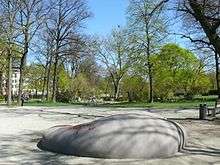Hostile architecture

Hostile architecture is an urban design trend in which public spaces are constructed or altered to discourage people from using them in a way not intended by the owner.[1] Also known as defensive architecture, hostile design, unpleasant design, or defensive urban design it is most typically associated with "anti-homeless spikes" — studs embedded in flat surfaces to make sleeping rough uncomfortable and impractical.[2][3] Other measures include sloped window sills to stop people sitting, benches with armrests positioned to stop people lying on them, and water sprinklers that "intermittently come on but aren't really watering anything."[4][5] Hostile architecture also seeks to deter skateboarding, littering, loitering, and public urination. Critics argue that such measures reinforce social divisions and create problems for all members of the public, especially seniors, people with disabilities, and children.[6]
Background
Although the term "hostile architecture" is recent, the use of civil engineering to achieve social engineering is not: antecedents include 19th century "urine deflectors".[7][8] Its modern form is derived from design philosophy, Crime Prevention through Environmental Design which aims to prevent crime or protect property through three strategies: natural surveillance, natural access control, and territorial enforcement.[9] The Seattle Department of Transportation installed bicycle racks to prevent the homeless from camping.[10] A gas station in New Kensington, Pennsylvania installed blue lighting in their bathrooms that make it hard for drug users to find their veins.[11]
Critics of hostile architecture argue that it makes contrarianism impossible, that it replaces public spaces with commercial or "pseudo-public" spaces and uses architecture "to enforce social divisions".[12][13]
In 2018 British artist Stuart Semple created a social media public awareness campaign encouraging the public to place identifying stickers on instances of hostile design in their environment.[14][15][16]
Gallery
.jpg) Bolts installed on the front steps of a building in France, to discourage sitting and sleeping
Bolts installed on the front steps of a building in France, to discourage sitting and sleeping "Sitzkiesel" ("sitting-pebble") replacing a former bench in the Kleiner Tiergarten park in Berlin, Germany
"Sitzkiesel" ("sitting-pebble") replacing a former bench in the Kleiner Tiergarten park in Berlin, Germany Spikes added around fountain in Government Center, Miami, in 2011 at downtown transit center
Spikes added around fountain in Government Center, Miami, in 2011 at downtown transit center Two short benches used instead of one long one
Two short benches used instead of one long one
See also
References
- ↑ "hostile architecture". Macmillan Dictionary. Retrieved 23 February 2015.
- ↑ Omidi, Maryam (12 June 2014). "Anti-homeless spikes are just the latest in 'defensive urban architecture'". The Guardian. Retrieved 23 February 2015.
- ↑ Andreou, Alex (18 February 2015). "Anti-homeless spikes: 'Sleeping rough opened my eyes to the city's barbed cruelty'". The Guardian. Retrieved 23 February 2015.
- ↑ Quinn, Ben (13 June 2014). "Anti-homeless spikes are part of a wider phenomenon of 'hostile architecture'". The Guardian. Retrieved 23 February 2015.
- ↑ Mills, Chris (21 February 2015). "How 'Defensive Architecture' Is Ruining Our Cities". Gizmodo.com. Retrieved 23 February 2015.
- ↑ Chellew, Cara (January 21, 2018). "#defensiveTO". #defensiveTO.
- ↑ Swain, Frank (2 December 2013). "Secret city design tricks manipulate your behaviour". BBC.
- ↑ Lee, Jackson (23 July 2013). "Urine Deflectors in Fleet Street". The Cat's Meat Shop. Retrieved 23 February 2014.
- ↑ Chellew, Cara (2016). "Design Paranoia" (PDF). Ontario Planning Journal. 31 – via ResearchGate.
- ↑ Groover, Heidi (19 December 2017). "Seattle Uses Bike Racks to Discourage Homeless Camping". The Stranger. Retrieved 17 December 2017.
- ↑ Watts, Amanda (December 7, 2017). "Gas station installs blue lights to combat drug use". CNN. Retrieved 6 March 2018.
- ↑ Swain, Frank (5 December 2013). "Designing the Perfect Anti-Object". Medium. Retrieved 23 February 2015.
- ↑ Shea, Michael (5 August 2014). "On the frontline: The architectural policing of social boundaries". Discover Society. Retrieved 23 February 2015.
- ↑ "Hostile Architecture: 'Design Crimes' Campaign Gets Bars Removed from Benches - 99% Invisible". 99% Invisible. Retrieved 2018-02-15.
- ↑ "Stuart Semple launches campaign to eradicate 'hostile design' around the world". www.theartnewspaper.com. Retrieved 2018-02-15.
- ↑ "Artist Launches Campaign to Call Out Hostile Urban Design". Hyperallergic. 2018-02-01. Retrieved 2018-02-15.
External links
- Cara Chellew, Bars, barriers and ghost amenities: Defensive urban design in Toronto Torontoist.
- Lloyd Alter, Hostile design doesn't work for any age group Mother Nature Network.
- Cara Chellew, Defensive Inequalities Spacing Magazine.
- "When Design Is Hostile On Purpose". Popsci. Popsci. Retrieved 16 August 2017.
- HostileDesign.org, Project homepage of Stuart Semple sticker campaign.